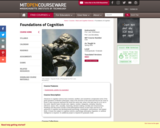
Text and links to all ancillary materials for Module 15
- Subject:
- Psychology
- Social and Behavioral Sciences
- Material Type:
- Module
- Reading
- Teaching/Learning Strategy
- Author:
- Brice Kuhl
- Nicole Dudukovic
- Date Added:
- 05/31/2021

Text and links to all ancillary materials for Module 15

Major narrative texts from diverse Western cultures, beginning with Homer and concluding with at least one film. Emphasis on literary and cultural issues: on the artistic significance of the chosen texts and on their identity as anthropological artifacts whose conventions and assumptions are rooted in particular times, places, and technologies. Syllabus varies, but always includes a sampling of popular culture (folk tales, ballads) as well as some landmark narratives such as the Iliad or the Odyssey, Don Quixote, Anna Karenina, Ulysses, and a classic film. This class will investigate the ways in which the formal aspects of Western storytelling in various media have shaped both fantasies and perceptions, making certain understandings of experience possible through the selection, arrangement, and processing of narrative material. Surveying the field chronologically across the major narrative genres and sub-genres from Homeric epic through the novel and across media to include live performance, film, and video games, we will be examining the ways in which new ideologies and psychological insights become available through the development of various narrative techniques and new technologies. Emphasis will be placed on the generic conventions of story-telling as well as on literary and cultural issues, the role of media and modes of transmission, the artistic significance of the chosen texts and their identity as anthropological artifacts whose conventions and assumptions are rooted in particular times, places, and technologies. Authors will include: Homer, Sophocles, Herodotus, Christian evangelists, Marie de France, Cervantes, La Clos, Poe, Lang, Cocteau, Disney-Pixar, and Maxis-Electronic Arts, with theoretical readings in Propp, Bakhtin, Girard, Freud, and Marx.

Advances in cognitive science have resolved, clarified, and sometimes complicated some of the great questions of Western philosophy: what is the structure of the world and how do we come to know it; does everyone represent the world the same way; what is the best way for us to act in the world. Specific topics include color, objects, number, categories, similarity, inductive inference, space, time, causality, reasoning, decision-making, morality and consciousness. Readings and discussion include a brief philosophical history of each topic and focus on advances in cognitive and developmental psychology, computation, neuroscience, and related fields. At least one subject in cognitive science, psychology, philosophy, linguistics, or artificial intelligence is required. An additional project is required for graduate credit.

" This team-taught multidisciplinary course provides information relevant to the conduct and interpretation of human brain mapping studies. It begins with in-depth coverage of the physics of image formation, mechanisms of image contrast, and the physiological basis for image signals. Parenchymal and cerebrovascular neuroanatomy and application of sophisticated structural analysis algorithms for segmentation and registration of functional data are discussed. Additional topics include: fMRI experimental design including block design, event related and exploratory data analysis methods, and building and applying statistical models for fMRI data; and human subject issues including informed consent, institutional review board requirements and safety in the high field environment. Additional Faculty Div Bolar Dr. Bradford Dickerson Dr. John Gabrieli Dr. Doug Greve Dr. Karl Helmer Dr. Dara Manoach Dr. Jason Mitchell Dr. Christopher Moore Dr. Vitaly Napadow Dr. Jon Polimeni Dr. Sonia Pujol Dr. Bruce Rosen Dr. Mert Sabuncu Dr. David Salat Dr. Robert Savoy Dr. David Somers Dr. A. Gregory Sorensen Dr. Christina Triantafyllou Dr. Wim Vanduffel Dr. Mark Vangel Dr. Lawrence Wald Dr. Susan Whitfield-Gabrieli Dr. Anastasia Yendiki "

Text and links to all ancillary materials for Module 31

Text and links to all ancillary materials for Module 10

This is the full course content for a course on General Psychology. It contains eight modules: Foundations of Psychology; Biopsychology; Consciousness and Sleep; Sensation and Perception; Learning, Memory, and Intelligence; Motivation and Emotion; Personality, Developmental Psychology, and Social Psychology; Psychological Disorder and Treatment, Abnormal Behavior and Health Psychology

Emphasis will be placed upon application of psychological knowledge to daily situations, and upon accessing and assessing information from a variety of sources about behavior. Skills in scientific reasoning and critical thinking will be developed during this course. Areas of psychology to be included are: research methods, neuroscience, human development, perception, consciousness, learning, memory, intelligence, motivation, emotion, personality, psychological disorders, psychotherapy, stress and health, and social psychology.Login: guest_oclPassword: ocl

Text and links to all ancillary materials for Module 52

Text and links to all ancillary materials for Module 38

This module provides an introduction and overview of the historical development of the science and practice of psychology in America. Contains text and all ancillary materials.

This volume brings together a collection of seven articles previously published by the author, with a new introduction reframing the articles in the context of past and present questions in anthropology, psychology and human evolution. It promotes the perspective of ‘integrated’ social science, in which social science questions are addressed in a deliberately eclectic manner, combining results and models from evolutionary biology, experimental psychology, economics, anthropology and history. It thus constitutes a welcome contribution to a gradually emerging approach to social science based on E. O. Wilson’s concept of ‘consilience’.
Human Cultures through the Scientific Lens spans a wide range of topics, from an examination of ritual behavior, integrating neuro-science, ethology and anthropology to explain why humans engage in ritual actions (both cultural and individual), to the motivation of conflicts between groups. As such, the collection gives readers a comprehensive and accessible introduction to the applications of an evolutionary paradigm in the social sciences.
This volume will be a useful resource for scholars and students in the social sciences (particularly psychology, anthropology, evolutionary biology and the political sciences), as well as a general readership interested in the social sciences.

This multimedia reader examines how people use a humanities lens to make sense of what they experience, as well as share their experiences with the rest of the world. The information is presented using a pedagogical approach called reverse teaching, which introduces artifacts in their historical, social, political, personal, and other contexts. Along with the narrative, questions for creative and critical thinking prompt the reader to practice self-exploration.

This set of questions for use with quizzes and tests was created under a Round Four ALG Textbook Transformation Grant with an accompanying PowerPoint lecture set. The course uses the free and open Human Development sections of Boundless Psychology. Topics covered include:
Nature vs. Nurture
Piaget
Attachment
Freud
Erikson
Kohlberg
Childhood Development
Adolescent Development
Adulthood Development
Late Adulthood

This textbook introduces students to the role of interpersonal relationships in business, with an emphasis on communication.

This textbook will show you how to comprehensively analyze, investigate, and address escalating problems of economic inequality, violence, substance abuse, homelessness, poverty, and racism. It will provide you with perspectives and tools to partner with community members and organizations to promote a fair and equitable allocation of resources and opportunities.

This textbook introduces students to the basic concepts, trends, perspectives and interconnections of global society. Through readings, discussions, videos, webcasts and other activities, students examine the interdependence of people around the world and global issues that affect these relationships. It will provide an overview of the history and theoretical approaches that have created a global society through topics such as global politics, human rights, the natural environment, population, disease, gender, information technology, war and peace. This is a required course for the Global Studies Emphasis.

This open course for Introduction to Human Development is an adaptation of PsychologyWiki materials and was created under a Round Nine Textbook Transformation Grant.
Authors' Description:
In our transformation of PSYC 2103 Human Development we decided to divide the content into three units.
Unit 1: Overview, History and Biological Beginnings
Unit 2: Early Childhood to Adolescence
Unit 3: Young Adulthood to Death
Each unit includes:
Learning objectives
Things to consider: questions students should be thinking about while engaging with the content
PowerPoint Presentation
Readings from a variety of open text books
Activities
Supplemental readings and videos
If you have questions or would like access to the question/test bank please contact either
Elizabeth Dose, edose@highlands.edu
Katie Bridges, kbridges@highlands.edu

We are constantly bombarded by information, and finding a way to filter that information in an objective way is crucial to surviving this onslaught with your sanity intact. This is what statistics, and logic we use in it, enables us to do. Through the lens of statistics, we learn to find the signal hidden in the noise when it is there and to know when an apparent trend or pattern is really just randomness. The study of statistics involves math and relies upon calculations of numbers. But it also relies heavily on how the numbers are chosen and how the statistics are interpreted.
This work was created as part of the University of Missouri’s Affordable and Open Access Educational Resources Initiative (https://www.umsystem.edu/ums/aa/oer). The contents of this work have been adapted from the following Open Access Resources: Online Statistics Education: A Multimedia Course of Study (http://onlinestatbook.com/). Project Leader: David M. Lane, Rice University. Changes to the original works were made by Dr. Garett C. Foster in the Department of Psychological Sciences to tailor the text to fit the needs of the introductory statistics course for psychology majors at the University of Missouri – St. Louis. Materials from the original sources have been combined, reorganized, and added to by the current author, and any conceptual, mathematical, or typographical errors are the responsibility of the current author.

We are constantly bombarded by information, and finding a way to filter that information in an objective way is crucial to surviving this onslaught with your sanity intact. This is what statistics, and logic we use in it, enables us to do. Through the lens of statistics, we learn to find the signal hidden in the noise when it is there and to know when an apparent trend or pattern is really just randomness. The study of statistics involves math and relies upon calculations of numbers. But it also relies heavily on how the numbers are chosen and how the statistics are interpreted.
This work was created as part of the University of Missouri’s Affordable and Open Access Educational Resources Initiative (https://www.umsystem.edu/ums/aa/oer). The contents of this work have been adapted from the following Open Access Resources: Online Statistics Education: A Multimedia Course of Study (http://onlinestatbook.com/). Project Leader: David M. Lane, Rice University. Changes to the original works were made by Dr. Garett C. Foster in the Department of Psychological Sciences to tailor the text to fit the needs of the introductory statistics course for psychology majors at the University of Missouri – St. Louis. Materials from the original sources have been combined, reorganized, and added to by the current author, and any conceptual, mathematical, or typographical errors are the responsibility of the current author.